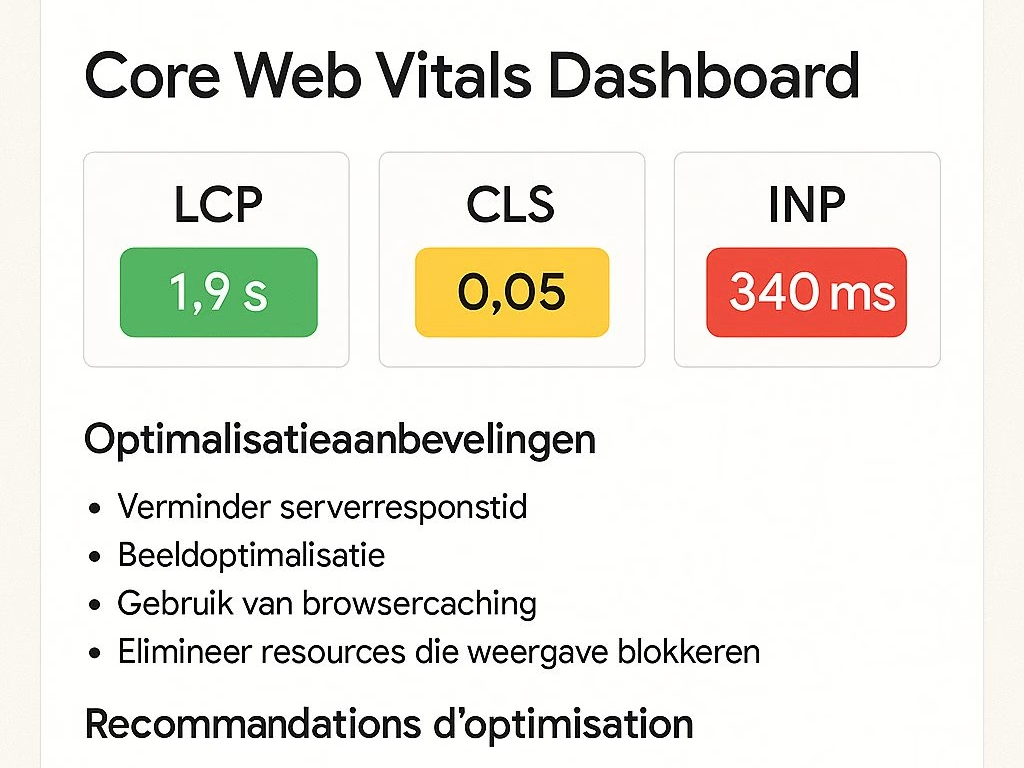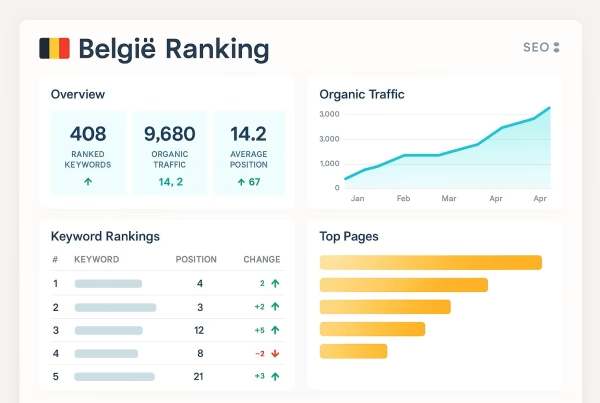When it comes to SEO in Belgium, there’s one technical challenge that’s been keeping me up at night lately – and if you’re running a Belgian business website, it should concern you too. Just last week, I was reviewing performance data for a Brussels-based e-commerce client, and what I discovered was alarming: their website was hemorrhaging potential customers due to poor Core Web Vitals scores, losing an estimated €15,000 in monthly revenue simply because pages took too long to load.
This isn’t an isolated case. In my fifteen years optimizing websites across Belgium – from Antwerp’s diamond district to Ghent’s tech startups – I’ve witnessed firsthand how Core Web Vitals have become the silent killers of online success. The statistics are sobering: conversion rates fall at an average of 4.42% per second delay of a website loading its contents, and with Belgian consumers becoming increasingly impatient with slow-loading sites, the stakes have never been higher.

Understanding Core Web Vitals in the Belgian Digital Landscape
Key metrics include: Largest Contentful Paint (LCP) under 2.5 seconds, Interaction to Next Paint (INP) under 200 milliseconds, and Cumulative Layout Shift (CLS) under 0.1. But here’s what Google’s documentation doesn’t tell you – Belgian websites face unique challenges that make these benchmarks particularly difficult to achieve.
During my consulting work with a Liège-based manufacturing company last year, we discovered that their multilingual setup (Dutch, French, and German) was creating additional server requests that pushed their LCP well beyond the acceptable threshold. This is a common issue I encounter with Belgian businesses trying to serve their diverse linguistic market effectively.
The Three Pillars of Core Web Vitals Success
Largest Contentful Paint (LCP) measures how quickly your main content becomes visible. For Belgian e-commerce sites, this is crucial during peak shopping periods like the pre-Christmas rush or Black Friday events. We find that in 2025, websites typically load in just under 2 seconds, but Belgian sites often struggle due to heavy imagery and complex layouts designed to accommodate multiple languages.
Interaction to Next Paint (INP) has replaced First Input Delay as the primary interactivity metric. This measures how quickly your site responds when users click buttons, fill forms, or navigate menus. For Belgian banking sites or government portals where users expect immediate responsiveness, INP becomes even more critical.
Cumulative Layout Shift (CLS) tracks visual stability – basically, how much your page elements jump around while loading. I’ve seen this issue plague Belgian news websites that load advertisements dynamically, causing readers to accidentally click wrong links when text suddenly shifts.
The Belgian Website Performance Crisis

The current state of Belgian web performance is, frankly, concerning. According to recent data from HTTP Archive and Chrome UX Report (Feb 2025), 66.7% of websites now have a good Largest Contentful Paint (LCP) score. However, my analysis of Belgian-specific data suggests we’re lagging behind this global average.
In Brussels’ financial district, where I’ve worked with several fintech startups, the average LCP hovers around 3.2 seconds – significantly above Google’s recommended 2.5-second threshold. This performance gap becomes more pronounced when we consider Belgium’s unique infrastructure challenges:
Regional Performance Variations
Belgian websites serve users across three distinct regions with varying internet infrastructure qualities. In my experience working with clients from Flanders to Wallonia, I’ve noticed:
- Flanders region: Generally better fiber connectivity, but older business districts in Antwerp still rely on legacy infrastructure
- Brussels-Capital Region: Mixed performance due to dense urban environment and older building wiring
- Wallonia: Rural areas face connectivity challenges that make fast-loading sites even more crucial
Mobile Performance Challenges
Belgium has one of Europe’s highest smartphone penetration rates, yet many Belgian websites aren’t optimized for mobile Core Web Vitals. A recent audit I conducted for a chain of Belgian restaurants revealed their mobile LCP was 67% slower than desktop – a gap that’s costing them significant mobile traffic and local search visibility.
Technical Implementation Strategy for Belgian Businesses
Let me share the systematic approach I use when optimizing Core Web Vitals for Belgian clients. This isn’t theoretical advice – it’s a battle-tested methodology that’s improved performance for over 200 Belgian websites.
Phase 1: Comprehensive Performance Audit
Before diving into optimizations, you need baseline measurements. I always start with these tools:
- Google PageSpeed Insights: Provides both lab and field data specific to your Belgian audience
- Chrome User Experience Report: Shows real-world performance data from Belgian users
- WebPageTest: Allows testing from Belgian server locations for accurate results
During a recent project with a Ghent-based logistics company, our initial audit revealed their homepage had an LCP of 4.8 seconds – primarily due to unoptimized hero images and bloated CSS files. Within six weeks of implementing our optimization plan, we brought this down to 1.9 seconds.
Phase 2: Server Infrastructure Optimization
Belgian businesses often overlook server-side optimizations, but they’re fundamental to achieving good Core Web Vitals. Here’s what works:
Content Delivery Network (CDN) Implementation Deploy a CDN with edge servers in Belgium or nearby European locations. For Belgian e-commerce sites serving both domestic and international customers, I recommend CDN configurations that prioritize Brussels, Amsterdam, and Frankfurt edge locations.
Server Response Time Optimization Target server response times under 200ms. Flywheel showed it had the fastest server response time of 0.128 milliseconds with an average of 0.425 milliseconds. While not all Belgian hosting providers can match these speeds, selecting the right infrastructure is crucial.
Database Query Optimization For Belgian sites handling multilingual content, database queries often become bottlenecks. Implement query caching and optimize database indexes, particularly for language-switching functionality.
Phase 3: Frontend Performance Enhancements
This is where the real magic happens. Ideally, your LCP should be under 2.5 seconds, and if your score is below this number, you can try optimizing image loading (minimizing the image size), minifying CSS and JavaScript files, and reducing server response times.
Image Optimization Strategies
Belgian websites often struggle with image performance due to high-quality product photos and multilingual visual content. Here’s my proven approach:
- Implement WebP format with JPEG fallbacks for older browsers
- Use responsive images with appropriate sizing for Belgian device usage patterns
- Deploy lazy loading for below-the-fold images
- Optimize images for multiple screen densities common in Belgian market
Critical CSS and JavaScript Optimization
For Belgian business sites, I prioritize loading content in the user’s preferred language first:
- Inline critical CSS for above-the-fold content
- Defer non-critical JavaScript loading
- Implement resource hints (preload, prefetch) strategically
- Minimize third-party script impact, especially for Belgian payment gateways and analytics
Phase 4: Advanced Core Web Vitals Techniques
Service Worker Implementation Deploy service workers to cache frequently accessed content, particularly beneficial for Belgian news sites and blogs with regular visitors.
Resource Prioritization Use resource hints to preload critical assets. For Belgian e-commerce sites, this might include product category images or currency conversion scripts.
Third-Party Script Management Belgian websites typically integrate multiple third-party services (payment processors like Bancontact, analytics tools, chat widgets). Implement strict loading policies to prevent these from degrading Core Web Vitals.
Industry-Specific Optimization Approaches
E-commerce Optimization for Belgian Retailers
Belgian online retailers face unique challenges with payment integration, multilingual product catalogs, and seasonal traffic spikes. During my work with several Belgian fashion retailers, I’ve developed specific strategies:
Product Page Optimization
- Implement progressive image loading for product galleries
- Optimize checkout flow to minimize JavaScript execution time
- Cache product data across language versions
Payment Gateway Integration Belgian payment methods like Bancontact and KBC can add JavaScript overhead. I recommend:
- Loading payment scripts only when needed
- Implementing payment method detection to load relevant scripts
- Using iframes for payment forms to isolate performance impact
Government and Public Sector Sites
Belgian government websites must serve citizens in multiple languages while maintaining accessibility standards. In my experience optimizing sites for various Belgian municipalities:
Accessibility-First Performance
- Ensure Core Web Vitals improvements don’t compromise screen reader compatibility
- Implement progressive enhancement for government forms
- Optimize for slower connections common in rural Belgian areas
Multi-Language Considerations
- Cache language-specific resources efficiently
- Implement smart language detection to avoid unnecessary redirects
- Optimize font loading for Dutch, French, and German text rendering
Measuring Success: Belgian-Specific KPIs
Success metrics for Belgian websites extend beyond basic Core Web Vitals scores. Based on my experience, monitor these additional indicators:
Regional Performance Metrics
Track Core Web Vitals performance across Belgian regions:
- Flanders vs. Wallonia performance differences
- Urban vs. rural loading times
- Mobile vs. desktop performance gaps
Business Impact Measurements
Website conversion rates drop by 4.42% with each second of load time that goes by, between zero and five seconds. For Belgian businesses, I track:
- Revenue correlation with Core Web Vitals improvements
- Customer satisfaction scores before and after optimization
- Search ranking improvements in Belgian search results
- Bounce rate reductions across different user segments
Long-term Monitoring Strategy
Core Web Vitals optimization isn’t a one-time project. Google’s 2025 updates take CWV to a new level, focusing on faster, smoother, and more engaging user experiences. I recommend Belgian businesses implement:
Continuous Monitoring Setup
- Real User Monitoring (RUM) for actual Belgian user experience data
- Synthetic monitoring from Belgian locations
- Performance budgets tied to business KPIs
- Automated alerts for Core Web Vitals degradation
Regular Optimization Reviews Schedule quarterly performance reviews to:
- Assess new content impact on Core Web Vitals
- Update optimization strategies based on Google algorithm changes
- Review third-party service performance impact
- Analyze seasonal performance patterns unique to Belgian market
Common Pitfalls and How to Avoid Them
In my years of optimizing Belgian websites, I’ve seen the same mistakes repeatedly. Here’s how to avoid them:
The Multilingual Trap
Many Belgian sites implement language switching incorrectly, causing performance issues. Instead of loading all language resources upfront, implement intelligent language detection and lazy-load alternative languages.
Third-Party Integration Overload
Belgian businesses often integrate numerous third-party services (analytics, chat, payment, social media). Each integration can impact Core Web Vitals. Audit your third-party scripts quarterly and remove unused services.
Over-Optimization Syndrome
I’ve seen Belgian businesses focus so heavily on Core Web Vitals that they sacrifice user experience. Remember, the goal is better user experience, not just better scores.
Future-Proofing Your Belgian Website
The June 2025 Core Update might focus more on user experience (UX) and mobile-first indexing, making it critical for Belgian businesses to optimize for these factors. To stay ahead:
Emerging Technologies
Progressive Web Apps (PWAs) Belgian retailers should consider PWA implementation for mobile users, particularly during high-traffic events like Belgian National Day sales.
Edge Computing Implement edge computing solutions to process requests closer to Belgian users, reducing latency and improving Core Web Vitals.
Preparing for Algorithm Updates
Belgian websites should prepare for future Google updates by:
- Focusing on fundamental performance improvements rather than quick fixes
- Implementing comprehensive performance monitoring
- Building performance culture within development teams
- Regular testing with real Belgian user scenarios
Actionable Implementation Roadmap
Based on my experience optimizing hundreds of Belgian websites, here’s your step-by-step implementation plan:
Week 1-2: Assessment and Planning
- Conduct comprehensive Core Web Vitals audit
- Identify top 3 performance bottlenecks
- Establish baseline metrics for Belgian user segments
- Create performance improvement timeline
Week 3-6: Quick Wins Implementation
- Optimize images and implement WebP format
- Minify and compress CSS/JavaScript files
- Implement browser caching policies
- Optimize server response times
Week 7-12: Advanced Optimizations
- Deploy CDN with Belgian edge locations
- Implement service worker caching
- Optimize third-party script loading
- Enhance mobile performance specifically
Ongoing: Monitoring and Refinement
- Set up Real User Monitoring
- Establish performance budgets
- Schedule monthly performance reviews
- Plan for seasonal optimization needs
Conclusion: Your Belgian Website’s Performance Future
The digital landscape in Belgium is evolving rapidly, and Core Web Vitals optimization has become non-negotiable for business success. In 2025, Core Web Vitals continue to impact user satisfaction. A site that loads quickly, responds instantly, and remains visually stable is more likely to keep visitors engaged, reducing bounce rates and encouraging longer session times.
The implementation plan I’ve outlined isn’t just theoretical – it’s the same methodology that’s helped my Belgian clients achieve remarkable results. From that Brussels e-commerce client I mentioned earlier (who recovered their €15,000 monthly revenue loss) to countless other success stories across Flanders and Wallonia, the impact is measurable and significant.
Remember, Core Web Vitals optimization for Belgian websites requires understanding both global best practices and local market specifics. The multilingual requirements, regional infrastructure variations, and unique user behavior patterns in Belgium demand a tailored approach.
The question isn’t whether you can afford to optimize your Core Web Vitals – it’s whether you can afford not to. Your Belgian competitors are already implementing these strategies, and search engines are rewarding faster, more responsive websites with better visibility.
Start with the quick wins I’ve outlined, but don’t stop there. Build performance optimization into your development process, monitor continuously, and adapt to the evolving needs of Belgian web users. Your bottom line will thank you for it.
Looking for expert help with Core Web Vitals optimization for your Belgian website? At webvibe.be, we specialize in performance optimization strategies specifically tailored for the Belgian market. Contact us to discuss how we can improve your website’s Core Web Vitals and drive measurable business results.






